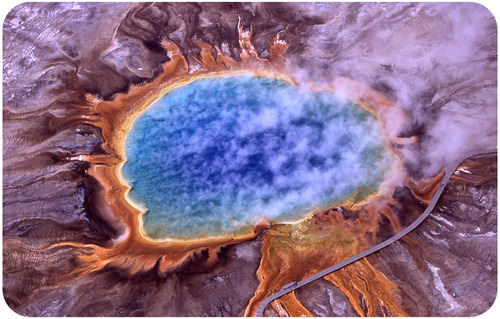4.11: First Cell
- Page ID
- 13524

What did the first life forms look like?
The first forms of life on Earth were probably smaller and simpler than even these bacteria. The first forms of life had to be simple single-celled organisms. But how did life begin on Earth?
Origin of Life
There is good evidence that life has probably existed on Earth for most of Earth’s history. Fossils of blue-green algae found in Australia are the oldest fossils of life forms on Earth. They are at least 3.5 billion years old (Figure below).

Life from Random Reactions
How did life begin? In order to answer this question, scientists need to know what kinds of materials were available at that time. We know that the ingredients for life were present at the beginning of Earth’s history. Scientists believe early Earth did not contain oxygen gas (photosynthesis had yet to evolve), but did contain other gases, including:
- nitrogen gas,
- carbon dioxide,
- carbon monoxide,
- water vapor,
- hydrogen sulfide.
Where did these ingredients come from? Some chemicals were in water and volcanic gases (Figure below). Other chemicals would have come from meteorites in space. Energy to drive chemical reactions was provided by volcanic eruptions and lightning. Today, we have evidence that life on Earth came from random reactions between chemical compounds, which formed molecules, or groups of atoms bonded together. Small molecules, such as those present in the early atmosphere, can provide the components (including the elements C, H, N, O and S) to make larger molecules. These early molecules further reacted and eventually formed even larger molecules and organic compounds, such as amino acids (which combine to form proteins), and nucleotides (which form nucleic acids - RNA or DNA). These organic molecules eventually came together in the right combinations to form basic cells. The components that were necessary for the formation of the first cells are still being studied.
How long did it take to develop the first life forms? As much as 1 billion years. Many scientists still study the origin of the first life forms because there are many questions left unanswered, such as, "Did proteins or nucleic acids develop first?" or "What exactly were early Earth's atmospheric conditions like?" There is a lot of work still left to answer these and similar questions.

Summary
- Life has probably existed on Earth for most of Earth’s history.
- Life on Earth came from random reactions between chemical compounds, which formed molecules.
Explore More
Use the resource below to answer the questions that follow.
- Thrombolites Differ From Stromatolites at http://www.youtube.com/watch?v=liKu6rC80gU (6:24)
- What are the environmental conditions like in Shark Bay? How does this differ from other oceanic conditions?
- What type of organism do scientists believe was responsible for the increase in oxygen (O2) in the Earth's atmosphere?
- What types of structures did these organisms build that scientists are studying today? How old are the oldest of these structures?
- When did the abundance of stromatolites go into decline? What else happened at this time?
- What are thrombolites? How do they differ from stromatolites?
Review
- How did life on Earth begin?
- Describe how the early atmosphere of Earth was different than it is today.
- List three gases present in the early atmosphere.
- How long did it take to develop the first life forms?

